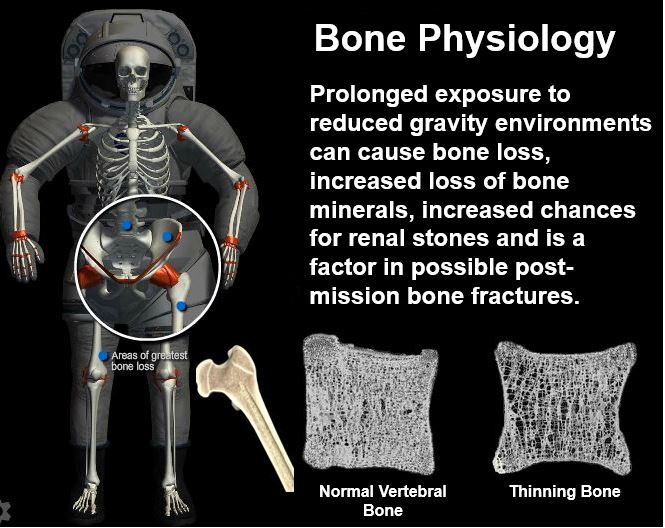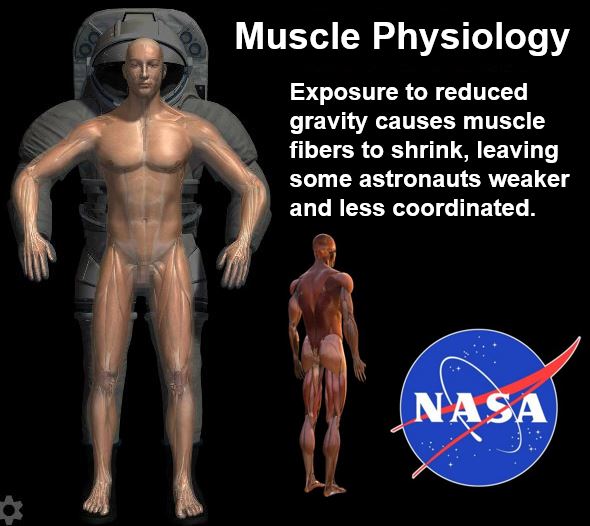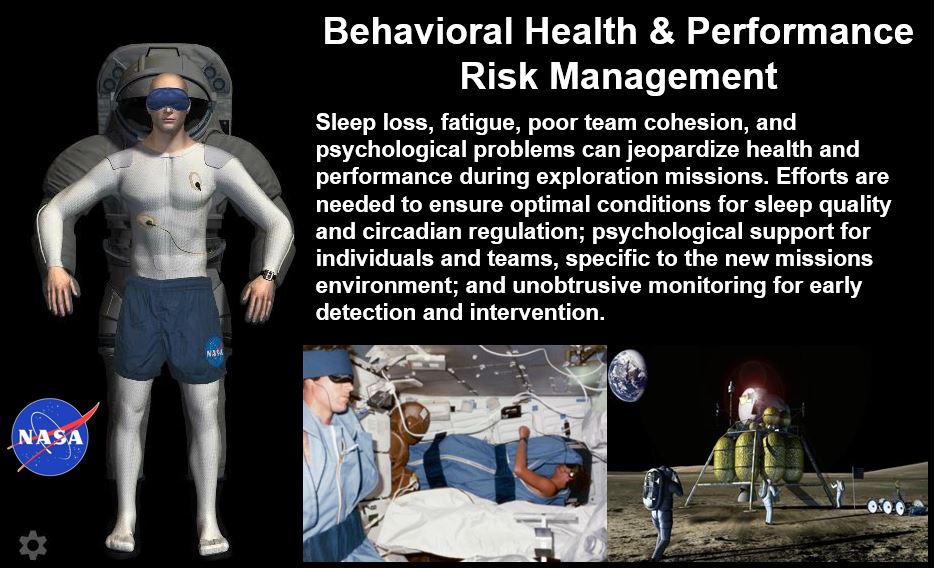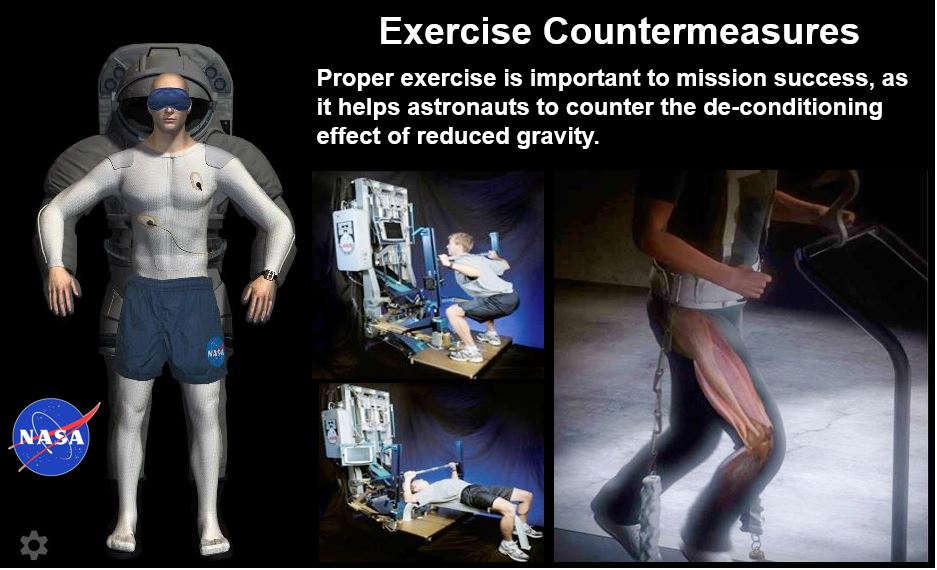When astronauts spend six months in space, they pay a high physical price, from a stretched-out spine, weakened skeletal muscles, a puffy face, reduced bone density, vision disturbances, a weakened immune system, a messed-up body-clock that interferes with their sleeping patterns, coordination problems, cardiovascular problems, and a poorer sense of taste and smell.
Spending several months in space, in a microgravity environment, i.e. you are weightless, can have a profound impact on the bodies of astronauts.
Most astronauts and cosmonauts (Russian astronauts) who stay at the International Space Station, which orbits Earth 250 miles from the surface, spend about six consecutive months there on each mission.
 Immediately after a 6-month ISS mission, crew members are at higher risk of bone fractures. (Image: www.nasa.gov)
Immediately after a 6-month ISS mission, crew members are at higher risk of bone fractures. (Image: www.nasa.gov)
Extensive tests have been carried out on three ISS astronauts who went up into space in March. NASA , ESA (European Space Agency) and Roscosmos (Russian Federal Space Agency) say the data gathered from these tests will be carefully analyzed and will give us a better understanding of how a microgravity environment can affect human health, and hopefully, what to do about it.
With future missions planned to Mars in the next decade, it will be crucial to know how astronauts’ bodies will cope, and what needs to be done. A Mars missions involves just 12 months non-stop travelling (6 months each way).
A year may not sound too long, but who knows what at least 12 months in a weightless environment can do, if just six months causes several physical problems.
Examples of physical problems caused by living in space:
The Spine: without any gravity our spine stretches and our height increases by about three percent, That means that a 6ft-tall person comes back to Earth 6ft 2ins tall after a six-month mission.
With no gravity pulling at the squishy spinal discs between vertebra, they are allowed to expand, a bit like relieving the pressure of weight on a spring. After coming back to Earth, that extra height is gradually lost as the body adapts to normal gravity again.
Muscles Shrink: human muscles start shrinking as soon as we are in space. If there is no weight to carry around, we need less muscle, so the body starts getting rid of some of it.
 Scientists are concerned about what could happen to astronauts’ muscle mass after 1 year or longer in future missions. (Image: www.nasa.gov)
Scientists are concerned about what could happen to astronauts’ muscle mass after 1 year or longer in future missions. (Image: www.nasa.gov)
ISS astronauts have to do about 2 hours exercise each day so that their muscle-loss is kept to a minimum. Despite their efforts, they still return with considerably less muscle mass after their six-month mission.
Most exercise in space involves resistance training with elastic band type devices and harnesses. For example, for a treadmill to work, you need to be strapped down, otherwise you would just float away.
Bone Density: an astronaut in space typically loses approximately 1% of his or her bone density each month if they don’t exercise regularly and strenuously.
Less dense bones means they are at higher risk of fractures when they return to Earth. Their symptoms are similar to those of patients with osteoporosis.
A good exercise regime and a carefully-balanced diet can help minimize the effect. However, so far, no matter how many measure are taken, all humans in space suffer from bone loss with time.
 Dr. James Thomas, Moore Chair of Cardiovascular Imaging and Lead Scientist for Ultrasound at NASA, was quoted by space.com as saying “The heart doesn’t work as hard in space, which can cause a loss of muscle mass. That can have serious consequences after the return to Earth, so we’re looking into whether there are measures that can be taken to prevent or counteract that loss.” (Image: www.nasa.gov)
Dr. James Thomas, Moore Chair of Cardiovascular Imaging and Lead Scientist for Ultrasound at NASA, was quoted by space.com as saying “The heart doesn’t work as hard in space, which can cause a loss of muscle mass. That can have serious consequences after the return to Earth, so we’re looking into whether there are measures that can be taken to prevent or counteract that loss.” (Image: www.nasa.gov)
Face Gets Puffy: About 60% of the human body consists of water. On Earth, gravity pulls liquids downwards, with some of it building up around our feet and ankles. In space there is no downward pull, so the liquid spreads around the body more evenly.
When we are in space, there is much more liquid circulating in our faces, which tend to look puffed up. Our feet and legs, on the other hand, look much thinner in a microgravity environment.
Scientists are not sure why, but within a few weeks of being in space, the body seems to adjust and some of the puffiness is gone.
 Astronauts on long missions need proper sleep in order to carry out complicated functions. (Image: www.nasa.gov)
Astronauts on long missions need proper sleep in order to carry out complicated functions. (Image: www.nasa.gov)
Eye Problems: According to some studies, many astronauts who spend more than three months in space had problems with their vision after their missions. In some cases, MRI scans showed that many of them had bloating around their optic nerve.
According to NASA, many astronauts experience poorer vision after their mission, some even for years after.
“MRI scans suggest that pressure changes in the brain and spinal fluid caused by weightlessness may be partly to blame. Many astronauts do not show these effects, though, and more advanced imaging techniques may be needed to understand the role of changing brain pressure in microgravity. This in turn will help researchers assess vision problems and develop ways to prevent them.”
Weakened Immune System: According to two NASA collaborative investigations, spaceflight may temporarily alter ISS crew members’ immune systems. NASA says this is of concern as it looks ahead to multiple-year missions to the Moon, asteroids and Mars.
 Despite all the exercise they do in space, the health problems still persist. However, physical activity helps reduce the deterioration. (Image: www.nasa.gov)
Despite all the exercise they do in space, the health problems still persist. However, physical activity helps reduce the deterioration. (Image: www.nasa.gov)
If a person’s immune system is compromised, something as simple as a cold on Earth could be risky business in space.
One of the two studies found that the distribution of immune cells in the blood of astronauts aboard ISS was relatively unchanged during their mission. However, they “also revealed that some cell function is significantly lower than normal, or depressed, and some cell activity is heightened. In a sense, the immune systems of crew members are confused.”
“When cell activity is depressed, the immune system is not generating appropriate responses to threats. This may also lead to the asymptomatic viral shedding observed in some crew members, which means latent, or dormant, viruses in the body reawaken, but without symptoms of illness. When activity heightens, the immune system reacts excessively, resulting in things like increased allergy symptoms and persistent rashes, which have been reported by some crew members.”
Messes up Sleep Cycle: After analyzing 10 years’ worth of data, NASA found that astronauts are not getting enough sleep, even though most of them take sleep medication during their ISS missions. The aim is for them to sleep 8 hours per day, but most of them only manage six.
 An artist’s impression of an ISS crew member sleeping in a sleeping bag located in a crew cabin. (Image: www.nasa.gov. Credit: Fred Sayers)
An artist’s impression of an ISS crew member sleeping in a sleeping bag located in a crew cabin. (Image: www.nasa.gov. Credit: Fred Sayers)
Recognizing that the best solution for sleep problems are not medications, scientists are currently trying to find better ways, such as changing astronauts’ daily schedules or using light that promotes sleep.
“Adequate sleep is essential for health, performance and safety, and a better understanding of how microgravity affects sleep and wake cycles could help not only astronauts, but the millions of people on Earth who suffer from insomnia.”
During their sleep period, ISS crew members have reported having dreams as well as nightmares. Some even snore in space!
Video – Spaceflight’s impact on astronauts’ health

